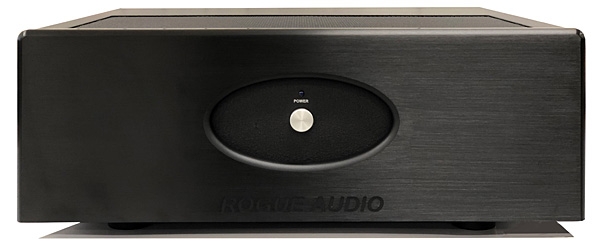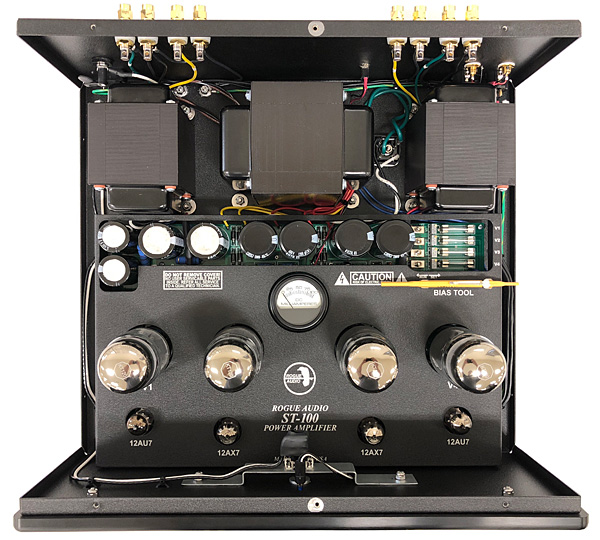| Columns Retired Columns & Blogs |
Another winner from Rogue Audio ($3,500) ......... Congratulations :-) ..........

But conspicuously missing from my audio menagerie has been a fast, neutral, 100Wpc tube amp to put more pop, fire, and maybe a little glow, into the Harbeth M30.2s.
After surveying what's available at working-class prices, I decided to start my auditions with Rogue Audio's all-tube, 100Wpc Stereo 100 amplifier ($3495).
Description
As I was told by Rogue's founder, president, and chief engineer, Mark O'Brien,
"The topology of the Stereo 100 begins with the transformer-coupled input stage. We use a very fancy Jensen transformer to get the balanced signal in. Many companies use a FET or other solid-state device on the input stage, but I prefer the sound (or lack thereof) of a high-quality transformer. This is an expensive way to couple the balanced signal, but it sounds really good, and has the added benefit that we can connect the RCA inputs through it to achieve much of the same noise-reduction benefits as the balanced inputs. The next stage is a 12AX7 voltage amplifier followed by a 12AU7 driver tube. We use the JJ Long plate Euro-spec versions (ECC802S and ECC803S) for all of these small-signal tubes.
"The output stage consists of a push-pull pair of Tungsol KT120 output tubes that can be operated in either Ultralinear or Triode mode via a switch on the rear panel. We use custom power and output transformers designed around the Stereo 100 circuit. Output power is 100Wpc in Ultralinear mode and about 60Wpc in Triode. The power supply is one of my favorite design areas, and is truly critical to the audio performance. Your readers might know that when you are listening to a power amp, you are effectively listening to the sound of the power supply being modulated by the audio signal.

"There are five separate power supplies in the Stereo 100—all of which utilize pi filtering to reduce ripple, thus providing a very low noise floor. Both of the Stereo 100's high-voltage supplies use large electrolytic capacitors for storage, all of which are bypassed by high-quality film capacitors. We also use very–high-quality parts throughout the Stereo 100, including aluminum/oil Mundorf coupling caps, lots of Vishay and PRP resistors, as well as Cardas hardware. The overarching design goal was to create an excellent-sounding, well-built power amp with a useful amount of power. To that end, I try to design a very accurate, low-distortion circuit and then just let the tubes add the magic."
Besides all that, the Stereo 100 is big and heavy: 18" wide by 7" high by 19" deep and 65 lb. It's remarkably old-school in incorporating no newfangled automatic tube-biasing circuits; instead, it requires the user to manually adjust the standing current (bias) for each of its four KT120 tubes. According to the manual, this is to be done during initial installation, following 15 minutes of warmup to stabilize the tubes, and then every four months thereafter.
It was easy to remove the vented, black-crinkle-painted top plate and spot the clamp-mounted bias tool just south of the four toggle switches (one per tube) and their associated bias pots, which can be adjusted by turning a brass screw. Mounted at the center of the steel subchassis is the conspicuously cool, vintage-looking milliamp meter, which, along with the tubes, can be easily seen and admired while looking in from above. Setting the bias is accomplished by flipping a tube's toggle switch from Run to Set, slowly turning that tube's bias screw until the meter reads close to 40mA, then flipping the switch back to Run before going on to the next tube. The entire idiot-proof process was fun and took me less than 10 minutes.
On the Stereo 100's rear panel are separate pairs of five-way binding posts, for loudspeakers with nominal impedances of 4 and 8 ohms; single-ended (RCA) and balanced (XLR) inputs; an IEC power inlet; and, to left of center, a toggle switch that lets you choose between triode and Ultralinear connection of the KT120 output tubes. The Stereo 100 is warranted for three years, its tubes for six months.
Sorry folks, but I must interrupt myself to tell a little side story. Today's ubiquitous short warranties for tubes remind me of when, in the 1990s, I bought some McIntosh tubed gear from a woman who was selling her late husband's stereo. She'd sent me a photo of the preamp and radio as they sat on a shelf in her living-room closet. When I asked about the amplifier(s), she told me that the original receipt listed them as "two McIntosh MC30s," but that she "didn't know what amplifiers looked like."
When I visited her house, on Long Island, the system, playing FM radio, sounded big and effortless. A pair of Altec A7 Voice of the Theatre horn speakers were hidden behind 6'-high gold-threaded grilles, mounted flush on opposing sides of an enormous flagstone fireplace.
When I extracted the industrial-grade Altecs from their tombs, I discovered, sitting on the cement floor behind each, a monoblock Mac. Like the horn speakers, they were thick with dust, rust, and mouse turds—and still working. Through the blanket of dust came the faint orange glow of their original General Electric 6L6 tubes. These once-shiny tube classics had been powered on continuously for over 30 years.
A six-month tube warranty?
Getting started
I plugged the Stereo 100 directly into a wall socket using Rogue's stock generic cord. After experimenting with wiring, I finally settled on Triode Wire Labs' Spirit interconnects and Auditorium 23's speaker cables, a combination that seemed to deliver the richest, most naturally lively, most three-dimensional presentation.
The Stereo 100's rear-panel toggle lets you choose between connecting its KT120 tubes' screen grids to an Ultralinear (UL) tap on the output transformer's primary or to the tubes' anodes, creating faux triodes. Per the owner's manual, the Stereo 100 is specified to output 100Wpc in UL, but no power rating is given for Triode mode. I assumed it would be about 30Wpc, but it appears I was wrong.
"When triode-connected, the Stereo 100 makes about 60W," Rogue's Mark O'Brien told me. That put a smile on my face: I have a historical tendency to favor triode operation. Fueled with anticipation, I began my serious listening by comparing the Stereo 100's Triode and UL modes with the Harbeth M30.2s connected to the Stereo 100's 4 ohm taps.
The first recording that fully captured my attention was a spectacular recommendation by Stereophile's Jason Victor Serinus: Chimère, a recital of French, German, and American art songs sung by soprano Sandrine Piau (24/96 FLAC, Alpha Productions 397/Qobuz). In these beautiful performances, the shimmering tones of Piau's voice set against the vibrating weightiness of Susan Manoff's concert grand let me compare Triode and UL operation.

Another winner from Rogue Audio ($3,500) ......... Congratulations :-) ..........

Pair this amp with Rogue RH-5 pre-amp/headphone amp ($2,500, Stereophile Class-A) ......... We have not only a great amp and pre-amp combo, we can also have a great headphone amp ........ Now, that can be a great "desert island" system :-) ..............

The interior of this amp looks a whole lot better than the $55,000 Constellation audio amp ....... This beauty is more than skin deep :-) .........

...continuously for over 30 years."
Perhaps more amazing, they surely suffered through numerous power outages of varying durations and degrees of abruptness, and simply came back on.

The early Mac amps don't have power switches. They were designed to either be run through the preamps like the C8 or C20, or be fed continual power like refrigerators.

God, this amplifier is so cool! I remember I've found lots of them and had no idea which one to choose. Actually, this one is such a thing! I mean finally I've found exactly what I need! To thanks you, I'd like to tell about one essay writing service. You can read more to learn something about it. It always helps me with all my college troubles, so I hope it's gonna be useful for you too!


"Monica Hunsinger":
Please don't pollute this environment with ads for fraudulent term-paper-writing services.

..to Mark O'Brien and the rest of the folk at Rogue Audio.
This review along with the pic of the ST 100's innards tell the story.
Their Stereo 100 is a HUGE amount of super-high quality amp for the bucks.
They just keep on whacking them out of the park.

Rogue Audio RP5 preamp, Sony HAP-Z1ES digital player feeding Joseph Audio Pulsar speakers. This was ~ 3 years ago.
It is still quite literally the best sounding system these well traveled ears have heard. Absolute magic. Well done Rogue Audio and Stereophile!

Rogue is made by people that answer the dam phone and sleep in Pennsylvania.
They seem to make nice Audio Gear and support their Customers.
They're able to hold on to Dealers for many years.
Looks, to me, like a worthy Company.
Thanks for taking the time on this one.
Tony in Michigan
ps. they even make an Audiophile Class D for Future thinking Solar Power People.

Great article - I have owned this amp for close to a year now. With all of the very expensive amplifier choices out there I am thankful that Rogue Audio considers price as a key factor. This amplifier is so good and competes well with amplifiers costing so much more. What a deal that flies in the face of escalating audiophile prices. The amp is built very well, dead quiet, delicate and powerful with wide soundstage, 3-D imaging and most importantly it conveys music with the body and size of the recording.

Herb should be reviewing 'modern take' JBL L-100 speakers ($4,000) ASAP, to go with this amp :-) ............

to the Harman store to audition the L-100s now......
hr

This is getting weird.
First I complained five years ago to Mikey that the Technics direct drive turntables were being deliberately ignored...and NOW Herb says the same thing about direct drive being (wow-finally!) a GOOD thing.
Then I found BBC monitors and specifically Harbeth Monitor 30s.
So did HERB.
Then I bought a stereo 100 watt Rogue amp (Cronus Magnum II).
So did Herb.
Hey.
Are you guys FOLLOWING me?
Just weird.
By the way Herb your writing is more entertaining than a monkey driving a Ferrari.
Take that anyway you want.
I meant it as a compliment.
Great review.

When JA posted my first Stereophile review, a reader commented, "Oh great, you finally found a worse writer than Cory Greenberg!" I was very flattered. Likewise with your compliment.
Thank you for taking the time to watch me try to reach the clutch peddle.
happy 2019
herb